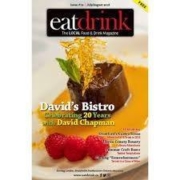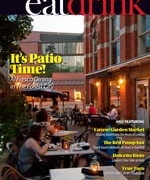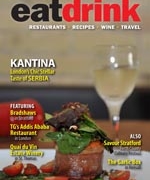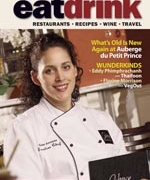Sensual Eating
We all know certain foods taste wonderful, but we rarely take the time to consider why they taste this way – the saltiness of your favourite potato chip, the spicy tingle of a curry, or the pleasant bitterness of coffee. Not to mention the flip side of the flavour equation and those foods we can’t stand to cross our tongues. Good or bad – that’s where science comes in. In her book, Taste What You’re Missing: The Passionate Eater’s Guide to Why Good Food Tastes Good, a professional food developer, Barb Stuckey, demystifies the science behind our food and makes gastronomic chemistry accessible to non-scientific-minded people who are just looking to eat good food. Each of us experience hundreds of flavours per day, but they are fundamentally broken down into five main tastes: sweet, sour, bitter, salt, umami. These are the tastes detected by the tongue alone, but other sensations can be a part of the eating experience. Stuckey writes: “Taste happens in your mouth, but that’s only about 20 percent of the story. Food that tastes good also looks good, smells good, feels good, and sounds good.” It is the working of all five senses together that create the ultimate flavour profiles in our mouths. Most of taste, in fact, comes from the aroma of the food wafting up through the nose; it is estimated that as little as 10% of flavour comes from taste and the other 90% from smell.
Each of the other senses also play a part, although each not a separate component, but rather a fusion of sensual information that provides the full perception of flavour. Stuckey writes: “Dining in a restaurant is one of the most complete multi-sensory experiences available to us on a daily basis.” We are probably not attuned to how noise influences flavour, but experiments prove the sound of waves on a shore in the background of a restaurant makes seafood taste more like the essence of where it comes from, or more seafood-y. High levels of auditory interference can even have a masking effect on taste – one reason airplane food isn’t usually good because the roar of jet engines overpowers subtle tastes. And, again under experimental conditions, Stuckey writes: “The human ear is so sensitive that people can tell the difference between hot and cold coffee simply by listening to the two being poured” There is even a theory out there that certain types of music will stimulate your brain to taste the nuances of certain wines. Apparently, “Sitting On the Dock of the Bay” by Otis Redding is perfect for optimizing the flavours of a Merlot and “All Along the Watchtower” by Jimi Hendrix will do the same for a Cabernet Sauvignon.
Texture or tactile sensation plays an important role in how tastes develop in your mouth, especially for those who have a decreased level of taste and smell perception. Ben Cohen, of Ben & Jerry’s ice cream fame, was fixated on textures in the creation of their ice cream flavours because he suffers from an inability to smell. He set out to compensate with textural indulgence in the form of chunky treats embedded in the ice cream, like crunchy chocolate-covered pretzels and moist fudge brownies.
Visually, food relies on colour and presentation to make the food palatable through our eyes before it hits our mouths; in grocery stores, we rely on images on packages to convince us to buy what’s inside. Sight can also have a confusing effect on taste. The phrase “We eat with our eyes” is true in research cases where beverages have been purposely miscoloured. Stuckey discovered, “If you are given an orange-coloured glass of apple juice to savour, you are likely to say that you taste orange juice. If you are given a glass of clear but flavoured liquid, you’re unlikely to recognize it as cola even if the beverage tastes exactly like the cola you drink every day.” Also, when we see someone not enjoying a certain food, either distastefully showing disgust on their face or gagging, we may also have a similar reaction even if it is a food we normally enjoy.
With all the senses at work at different levels and all the flavour combinations available, taste comes down to a very complex scientific process. And it is also a very personal phenomenon. Different people taste differently based on all kinds of reasons: genetics, brain activity, medical history, and taste bud density. Certain tastes are hard-wired in us; children often have a strong rejection toward bitter foods, like intense-tasting vegetables (broccoli, Brussels sprouts, etc.). Since babies “universally swallow anything, they’d be at great risk because they have undeveloped immune and digestive systems. An instinctive rejection of bitter foods is thus protective of human babies’ lives … Many vegetables have a bitter taste component, and rejecting bitter ensures that they won’t poison themselves before they know better.” Bitter tastes are a biological survival mechanism for babies to avoid toxic foods that hopefully doesn’t linger, or else coffee and tea could never be enjoyed later in life.
Umami is the most ambiguous of the basic tastes, and the Japanese inherently get it as an essence of flavour (the same way the French get the nuances that go into the word terroir). The English words to describe umami are savoury, meaty, and brothy. But even that is often not enough to fully express how umami plays in the mouth. Umami-rich ingredients like Parmesan cheese, soy sauce, mushrooms, and tomatoes have a high glutamate content, and are added to food to get that sometimes hard to describe, but deep and satisfying flavour.
The fat content of food, that people associate with less healthy, is also very important for imparting rich flavour. Fat coats the tongue and saturates the taste buds, making the flavour of fatty food linger longer in our mouths. Fatty food become our cravings because they pack the most flavour in every bite. One way to mimic the lasting effect of fatty foods with not-so-fatty ones is to chew food as long as possible making the flavour last. It is scientifically known as Fletcherizing, named after a man named Horace Fletcher, who “refused to swallow food until every last drop of flavor and every last shred of texture was gone from it. He once chewed a green onion 700 times before he deemed it ready to be swallowed.” Because it isn’t the swallowing that is the best part of eating, it should be the length of time of mastication. Fletcher was known for advising to chew eat bite at least 45 times. Making the meal last longer will extend the enjoyment of eating.
She even argues that taste research is essential for solving eating disorders, since so many health problems are eating-related (obesity, diabetes). If people can teach themselves to taste better through the senses, then maybe they will pay more attention to every bite and seek out tastier, and healthier, foods so “they don’t waste precious mouthfuls on food that doesn’t taste delicious.”
Taste What You’re Missing has moments of being a how-to book to improve your perceptions of flavour. There are interactive exercises to measure how many taste buds you have on your tongue, how to adjust your coffee with sugar and cream for the optimum level of bitterness, and a Spice Rack Aroma Challenge to detect the subtle smells within the spectrum of spices (without the benefit of taste or sight to go along with smell, this turns out to be much harder than you’d think). Stuckey offers these personal experiments as a way to learn how to make every bite count as a sensual experience. Knowing how to properly taste and season food can change your whole perspective about cooking; Stuckey writes: “You could go from feeling like an overworked short-order cook for your family to feeling like an inspired artist who feeds your creations to the ones you love.” Taste inspires creativity.
At the top of the tasting chain are wine tasters. Nothing has as much attention or rigour around its flavour as wine does. A simple wine tasting incorporates all the senses: the taste through the mouth, slurping the wine increases the aromas that resonate up through the nasal system, swirling the wine gives a visual impression in the glass, the tannin levels give degrees of texture, and to ensure sound is not left out, glasses clink together in a toast. Alcohol may be a vice of many people. But so are sweets. Oddly enough, Stuckey says: “It’s likely that sweet lovers aren’t drinkers, because the amount of alcohol you drink and how much sugar you eat are inversely correlated. There is a belief that the sensory satisfaction from alcoholic beverages scratches the same itch that sugar does … It’s no coincidence that sugar consumption skyrocketed in the United States following the prohibition of alcohol in the 1920’s.” If we put the attention toward each meal in the same vein as a wine taster, “our meals would progress more slowly and we would absorb much more sensory input. In the same way that the nutrients nourish our body, sensory input nourishes our psyche and makes a meal truly satisfying.”










